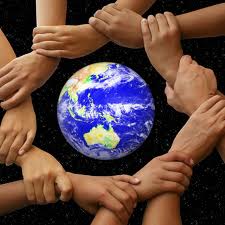
Most of us are quite aware of how connected we are. This awareness has produced several ways to think about, describe, or view this connectivity. The ideas run the gamut from highly interconnected to loosely so. The extent to which the internet has made us aware of these relationships, with more people and more information from around the world, it has become front of mind. Since how we think about nature structures our reality of it, it seems necessary to reconsider how we might view our connections to others.
Many people view these interactions from the perspective that we are more like billiard balls that inevitably come in contact with other billiard balls as we run around the world doing our thing. It recalls the classic view of the structure of reality at the atomic level. That matter comprises extremely tiny particles called atoms originated about 2500 years ago by Democritus, a Greek philosopher. However, the idea was forgotten for approximately 2000 years. Then, at the beginning of the 19th century, the English chemist John Dalton brought back Democritus’ ancient idea of the atom. Dalton thought atoms were the smallest particles of matter and envisioned them as solid, hard spheres, like billiard balls. Currently, matter as energy, electron clouds, or probability waves have replaced the old billiard ball model of matter.
Yet, the classic notion of matter has affected our conceptualization of human interactions. We view the inevitable result of human billiard balls making contact and colliding as producing change, but namely to redirect or reorient our own trajectory. If the impact is great, it may cause emotions to engage and the interactions can rise to another level. Even at this level, we think that our internal environment remains unchanged, except perhaps for a brief flash of exasperation, anger, or resentment.
As the collisions become greater and more pronounced, we may acknowledge that the changes stay with us for a while, perhaps even a lifetime. The accepted modern paradigm to describe this dynamic is what I characterize as independent arising. Each of us is seen as an independent agent, a billiard ball, exerting control over what we experience. Thus, what we feel and how we respond depends on our own mind, allowing itself to experience and determine our actions. There is a level of autonomy, control, and agency we attribute to our behavior.
This model, however, is incomplete and does not explain all of human behavior. Therefore, it is time to recognize alternative explanations. One of these is that we may be more like balls of gooey chocolate when we encounter and collide with others. When we do, we leave a trace—sometimes messy, sometimes not. Therefore, it isn’t unusual to hear someone say, “I needed a shower after meeting that person.” The psychic residue of our interactions can affect our internal being, our psyche and spirit, and can be difficult to wash off. I characterize this as dependent arising.
A sophisticated description of this idea is the doctrine of dependent arising, which stands at the heart of Buddhist doctrine. It describes the principle of conditionality or the links that arise between experiences. My simple understanding of this doctrine is that these links and our experience of those links arise dependent on every other circumstance we encounter. They arise because we have a body, emotional reactivity, perceive incoming sensory information, conceptualize such information, and develop a conscious awareness of these experiences. Or, to put it in more modern terms, we are born with a body whose function is to create connections and links between experiences, add emotional valence, and reflect on them.
Martin Luther King Jr. captured the point I want to emphasize about our deep interconnectedness in what he expressed about injustice. He said, “We are caught in an inescapable network of mutuality, tied in a single garment of destiny. Whatever affects one directly affects all indirectly.” The concept of interbeing introduced by Thich Nhat Hanh also reflects our deep interconnectedness, where everything relies on everything else in order to manifest. Likewise, biologists describe how our human bodies are shared, rented, and occupied by countless other tiny organisms, without whom we couldn’t “move a muscle, drum a finger, or think a thought.” Indeed, our body is comprised of trillions of bacteria, viruses, and other such organisms. Without them, we wouldn’t be able to operate, think, feel, or speak. In fact, the analogy applies to the entire planet, which can be conceived as one giant breathing entity, with all its working parts connected in symbiosis.
We are not separate entities or exist independently, but are a continuation of one another, as Thich Nhat Hanh has argued. This garment of symbiotic mutuality that we represent gives a different perspective on what it means to be in a relationship with others. It thus calls for a rethinking of how much agency, control, and independence we actually have and to structure our spiritual path accordingly. By spiritual I mean a recognition of the validity and impact of our deep interconnectedness.
